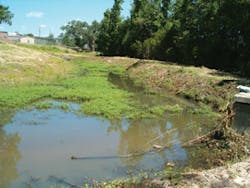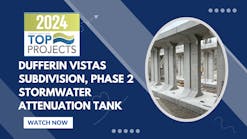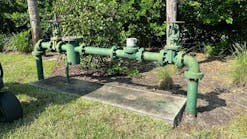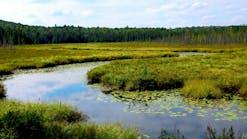Stormwater Ponds and Water Quality
Although a variety of stormwater management practices have been developed, the use of stormwater ponds is by far the most common practice employed to address coastal nonpoint source pollution (NPS) and flooding, particularly in coastal South Carolina (Law et al. 2008, Vandiver and Hernandez 2009). Stormwater ponds were one of the first recommended stormwater management practices by federal, state, and local agencies to reduce flooding potential. Today, coastal stormwater ponds are a common water feature and are an accepted practice by stormwater engineers, developers, designers, and permitting agencies for controlling stormwater runoff. Yet relatively little is known about the collective role of these best management practices (BMPs) in addressing NPS pollution.
Stormwater ponds were originally intended to manage localized flooding; however, over the past decade, they have been increasingly expected to (or in some states required to) address water-quality concerns for receiving waters, including the removal of pollutants (nutrients, bacteria, inorganic and organic contaminants, and sediment). In addition, stormwater ponds are often used for recreation (e.g., boating or fishing), to enhance aesthetics or to increase residential property value, and to provide wildlife habitat even where their intent was strictly for stormwater management (Hirschman et al. 2009, Schueler 2009). They also provide a source of fill material for site construction in low-lying coastal areas that would otherwise raise development costs.
Stormwater Management in South Carolina
The number of stormwater ponds in coastal South Carolina is currently unknown. However, stormwater permit applications increased from about 60 in 1992 to more than 1,300 in 2006 (Boulware, pers. comm., 2007). Seiwicki et al. (2007) estimated the number of ponds to be approximately 8,000 in the coastal area of South Carolina in 2006. If the rate is increasing by 13% annually, then the number could be well over 27,000 today (Weinstein et al. 2010).
In South Carolina’s coastal counties, stormwater ponds are one allowable option (and the most popular option) to meet the performance requirements for stormwater runoff (see South Carolina Stormwater Management and Sediment Reduction Regulations at South Carolina Code of Regulations 72-300 et seq., the National Pollution Discharge Elimination System (NPDES) General Permit for Stormwater Discharges from Construction Activities, and the South Carolina Coastal Zone Management Program Refinements). To protect water quality during construction and development, the state (or municipal separate storm sewer system (MS4) local government under Phase II NPDES requirements) generally requires a permit for projects within 0.5 mile of a receiving waterbody or that disturb greater than 1 acre. For certain land disturbance activities, state regulations require that peak post-development discharge rates from the site must be at or below predevelopment rates for the two- and 10-year, 24-hour storm events (approximately 4.5- and 6-inch rain events, respectively, but this varies regionally). Typically, projects within 0.5 mile of a receiving waterbody should catch and store onsite the first 0.5 inch of runoff from the site or the first 1 inch of runoff from the built-upon area, whichever is greater. During construction, a site-level stormwater management plan should demonstrate an 80% sediment trapping efficiency for the 10-year, 24-hour storm event if the project disturbs greater than 10 acres and drains to a common point (SCDHEC 2002, 2003, 2006). It is important to note that stormwater ponds are considered engineered stormwater treatment structures, and are therefore not regulated as “waters of the state” under the federal Clean Water Act and related state laws and regulations. Because they are treatment structures, they are likely (by design) to accumulate contaminants, sediments, and nutrients at higher concentrations. Also for this reason, they are not subject to standard monitoring requirements, nutrient or contaminant criteria, water-quality warnings or closures, total maximum daily loads (TMDLs), or other management approaches. Although fishing, swimming, boating, or other activities are not expressly prohibited by law or regulation in South Carolina, many homeowners associations add signage to this effect, and some commercial sites include fences around the perimeters of stormwater ponds for health or safety reasons. Still, stormwater ponds continue to be used as a recreational amenity in many areas along the coast and are often advertised as “lagoons” in real estate property listings or characterized as an additional amenity.
Baseline Water-Quality Assessment
In the southeastern US, there is evidence that ponds can have negative impacts on environmental quality and/or human health, and can act as “incubators” for harmful algal blooms (HABs) (Lewitus et al. 2003, Lewitus and Holland 2003, Brock 2006, Drescher et al. 2007, Lewitus et al. 2008, Delorenzo and Fulton 2009) and/or fecal coliform bacteria (Mallin 2000, Mallin et al. 2001). Most of this research, however, has focused on ponds with suspected water-quality problems or ponds on barrier islands of South Carolina. In addition, stormwater ponds can discharge directly into tidal waters and marshes. Cumulative impacts on receiving waters, habitats, and associated fisheries are unknown; however, coastal estuaries serve as critical nursery habitats for economically important fisheries species. Past studies have documented impacts on water quality in southeastern estuaries and tidal creeks from increasing urban development and impervious cover (roofs, parking lots, roads, etc.) (Holland et al. 2004, Schueler 2009).
To better understand pond water quality throughout the coastal area of South Carolina, the South Carolina Department of Health and Environmental Control’s Office of Ocean and Coastal Resource Management (SCDHEC-OCRM) conducted a baseline assessment of coastal stormwater ponds (Figure 1). The study was conducted from May to October of 2006 with a total of 112 ponds sampled. Sampled ponds were greater than 10 years old and represented a range of South Carolina’s coastal geographies and surrounding land uses. A database of permit records was developed from which sampling sites were randomly selected for visual identification using aerial photographs and subsequent pond selection. To maximize sampling efforts, numerous ponds were sampled near the randomly identified permit.
Using GIS software, the surface area, perimeter, length, width, and distance to nearest receiving water were determined for each pond. The primary surrounding land use was identified for each pond proposed for sampling to ensure that a range of land-use types (residential, industrial, commercial, and golf course) were included. Site rainfall was recorded for one, two, three, and seven days prior to sampling using the nearest weather station (Southeast Regional Climate Center or site records).
Water temperature, dissolved oxygen (DO), salinity, and specific conductivity were collected using a YSI 85 meter. Water samples were collected between 10 a.m. and 2 p.m. at a depth of 1 foot near the stormwater pond outfall within the pond. Water samples (whole fraction) were analyzed for nitrate plus nitrite (method Lachat QuickChem 10-107-04-1-C), total nitrogen (sum of TKN [Lachat QuickChem 10-107-06-2-E] and nitrate plus nitrite), ammonia-nitrogen (Lachat QuickChem 10-107-06-1-C), total phosphorus (Lachat QuickChem 10-115-01-1-E), orthophosphorus (Lachat QuickChem 10-115-04-1-A), fecal coliform bacteria (SM9221C E), chlorophyll a and phaeopigment (SM10200 H), total suspended solids (SM2540D), and algal screening (preserved with lugols). When pond conditions indicated an algal bloom (visual observation or DO > 100% saturation), water samples were also collected for live algal screenings. Hypereutrophic pond samples (chlorophyll a > 60 µg L-1, according to Bricker et al. 2003) were also screened for algal composition including HABs using the lugol preserved samples (Hasle 1978, Guillard 1978). To ensure that quality data were gathered that could support decision making for the agency, a quality assurance and project plan was developed, reviewed, approved, and implemented as per the SCDHEC Quality System procedures, which follow EPA guidance (SCDHEC 2000).
coastal zone counties
(no more than 10% of samples can exceed 400 per 100 mL in 30 days) (SC Regulations R 61-68).
2Hypoxia exists when > 0 but < 2 mg L-1 (Bricker et al. 2003) and freshwater standards < 4 mg L-1 are not allowed (SC Regulations R 61–68).
3Surface concentrations are low and medium for < 20 μg L-1, high for > 20 to < 60, and hypereutrophic at > 60 μg L-1 (Bricker et al. 2003).
4Reported normal values were < 0.95 mg L-1 (SCECAP 2002) and should not exceed 1.5 mg L-1 (SC Regulations R 61–68).
5Should not exceed 0.09 mg L-1 (SC Regulations R 61-68) and highly enriched values were > 0.17 mg L-1 (SCECAP 2002).
6USEPA treatment technology for municipal wastewater treatment plants must provide treatment to meet TSS limits of 30 mg L-1
monthly averages (http://www.michigan.gov/documents/deq/wb-npdes-TotalSuspendedSolids_247238_7.pdf).
Stormwater Pond Water Quality
South Carolina’s coastal stormwater ponds vary greatly in size, shape, surrounding land uses, inflow and outfall structures, drainage area, and maintenance practices. GIS analysis determined that 72% of ponds were within 0.5 mile of a receiving water body, indicating most of these stormwater ponds could easily connect with or discharge directly into a tidal creek, marsh, or coastal river. No “littoral shelves” or forebays were recorded in any of the ponds surveyed. Most ponds had a very low surface salinity (< 1 ppt), which indicated either lack of mixing or low saltwater intrusion via groundwater or surface connections (this may be more common for barrier island sites with sandy soils, higher water tables, or direct tidal exchange).
Fecal coliform bacteria levels in 23% of the ponds sampled were greater than 400 colony forming units (CFU) 100 mL-1. In comparison, if stormwater ponds were regulated for water quality, no more than 10% of samples can exceed 400 CFU in a 30-day period or a no-contact recreation advisory is issued for shellfish in coastal waters (SC Regulations R 61-68) (Figure 2). The highest fecal coliform bacteria concentrations occurred after rain events, as indicated by the positive correlation with previous rainfall one, two, three, and seven days prior to sampling
(p < 0.001). This relationship has also been observed in other studies (Mallin et al. 2001, Brock 2006, Messersmith 2007). High bacteria levels could be the result of domestic animal waste, sanitary contamination, and/or wildlife inputs. The size of the watershed or catchment area for each pond may contribute significantly to fecal coliform bacteria contamination. For example, Weinstein sampled 16 of the same ponds used in this study and found that watershed size was a significant factor for larger watersheds in explaining sediment contamination levels (Weinstein et al. 2010). Better information is needed for these older ponds to determine their drainage area, which could improve this data interpretation.
Twenty-seven percent of ponds had aerators, and these ponds had average DO levels of 6.1 mg L-1 (minimum = 0.4 mg L-1, maximum = 9.9 mg L-1). These aerators were either installed as a fountain for aesthetics or they were installed due to water-quality problems. Ten percent of ponds were found to have DO concentrations less than 2 mg L-1 or were considered hypoxic, a value considered detrimental to organisms (Figure 2), and 21% of ponds were supersaturated (> 100% DO) with algal blooms often present. Chlorophyll a levels are an indicator of phytoplankton primary productivity, and levels greater than 60 µg L-1 were considered hypereutrophic. Hypereutrophic conditions are indicative of algal blooms, excessive nutrients, submerged aquatic vegetation die-offs, and low bottom water DO levels. Chlorophyll a levels greater than 20 µg L-1 were considered eutrophic and are indicative of submerged aquatic vegetation declines and community shifts to monocultures (Bricker et al. 2003). Twenty-two percent and 35% of the ponds sampled had chlorophyll a concentrations in the hypereutrophic and eutrophic ranges, respectively. In addition, the chlorophyll a to phaeophytin concentrations were found to be greater than 1, which indicates the algae were in the growth phase and increasing in abundance for all but two of the eutrophic ponds sampled.
One of the primary water-quality concerns identified in sampled stormwater ponds were algal blooms, because some of the algae species found in bloom proportions were toxin producers (HABs) or suspected HABs. To determine the presence of algal blooms, live screens were conducted for ponds with suspected blooms (e.g., high DO or visual inspection) (19% or 21 ponds) and nine ponds were confirmed to contain ongoing blooms. To determine the presence of HABs, fixed screens were conducted on ponds with hypereutrophic (> 60 µg L-1) chlorophyll a concentrations (22% or 25 ponds) using samples preserved with lugols. Of the ponds considered hypereutrophic, 84% contained algal blooms with one to several species in bloom proportion. Samples that contained at least one algae organism with > 1,000 cells mL-1 or Pfisteria-like organisms (PLOs) with > 100 cells mL-1 were considered algal bloom(s). PLOs were determined using polymerase chain reaction analysis. Results from the fixed algal screening showed that algal bloom species were almost exclusively from the class Cyanophyceae and the three most frequent genera were Aphanizomenon, Microcystis, and Oscillatoria. Algal blooms in 21 ponds (18%) had at least one bloom containing toxin-producing algae. In fact, all but one bloom sample had > 1 algal species documented to be a suspected or known toxin producers (i.e., harmful) (Brock 2006).
multiple HABs in bloom.
Nutrient concentrations (total nitrogen and total phosphorus) were generally found to be at low levels. High total nitrogen levels (> 1.5 mg L-1) were observed in only 7% of the ponds studied, and high total phosphorus levels (> 0.17 mg L-1) were found in only 16% of the ponds studied (Figure 2). However, high chlorophyll a levels indicate that nutrients entered the ponds and were rapidly consumed. Nutrient input to stormwater ponds can promote algal growth, increasing morning respiration rates and resulting in reduced oxygen levels and fish kills.
Total suspended solids were found to be elevated (> 30 mg L-1) in only 13% of the ponds sampled (Figure 2). Previous research by Weinstein and others (Marsalek et al. 2002, Sparling et al. 2004, Weinstein et al. 2008, Weinstein et al. 2010) have found high concentrations of chemical contaminates in stormwater pond sediments, which indicates that the particles coming into these systems are likely retained along with some chemical contaminants. The degree to which resuspension may play a role in the transport of sediments and associated contaminants out of ponds is unknown.
Summary
This project represented an effort to randomly sample a subset of the ponds in coastal South Carolina to determine the extent to which ponds are presently exhibiting poor water quality or characteristics that may present public health concerns. Ponds that had “good” water-quality attributes and that exhibited few factors for human health concern were recorded; however, there were also ponds with “poor” water-quality attributes such as high bacteria, numerous algal blooms where toxic algae were present, and low DO levels. Low total phosphorus and total nitrogen levels could be due to uptake of these nutrients by algae. In fact, a total of 61 ponds (54%) had poor water quality for one of the six parameters categorized or were experiencing an algal bloom at the time of sampling. During rain events, this water may be released directly into South Carolina’s estuarine habitats (Messersmith 2007). In addition, given the limited number of algal screens conducted in this study, the high number of toxin-producing HABs found may be important from a public health perspective. Furthermore, although funding levels limited the algal screens in this study, additional screens could have yielded even higher toxin-producing HAB findings. The findings of this study generally agree with those of other studies of pond conditions in the southeastern coastal zone (e.g., Mallin (2000), Mallin et al. (2001), Lewitus et al. (2003) Lewitus and Holland (2003), Brock (2006), Serrano and Delorenzo (2008), Delorenzo and Fulton (2009), and Lewitus et al. (2008)).
These findings indicate that stormwater pond discharges may be a concern for receiving waters, especially because ponds may discharge at higher rates than allowed by regulations (Messersmith 2007, Hancock et al. 2010). In this study, the history of pond maintenance by landowners was usually unknown, as was the role of pond size, depth, and additional pond attributes that could relate to pond performance. Future research efforts should determine the hydrology, topography, impervious cover, maintenance issues, and land-use impacts on stormwater pond effectiveness. Determining what factors influence the stormwater pond’s poor or adequate function is important, but proved to be a complicated matrix in this study. Additional studies are needed to build on the expanding body of research to determine the major factors that indicate pond function, provide solutions for failing systems, and inform better management options.
Both the private and public sector will continue to use ponds as a stormwater management practice. However, stormwater ponds should not be expected to ameliorate flooding, protect receiving waterbodies from a full suite of contaminants and nutrients, and provide recreational or aesthetic amenities without some environmental and public health implications. These findings can be used to support improved short- and long-term stormwater practices, and points to a strong need for additional research, especially with respect to the influence of pond design on performance. An overall management strategy that uses ponds as one tool in the toolbox, along with low-impact-development practices (Vandiver and Hernandez 2009), runoff reduction, and other management approaches, is recommended.






